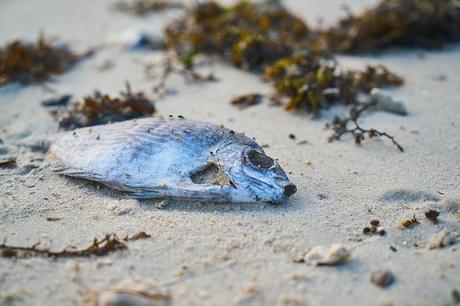A decade after the Deepwater Horizon oil spill, thousands of fish in the Gulf of Mexico have been detected with oil pollution, including popular seafood choices like yellowfin tuna, tilefish, and red drum with higher levels of contamination, as per a recent study.
Between 2011 and 2018, the research was carried out with samples containing more than 2,500 individual fish living in 359 different locations in the Gulf that belonged to 91 species. Oil exposure found in all of them.

The BP oil spill became the largest accidental oil spill in US history when the Deepwater Horizon explosion took place 10 years ago, and millions of gallons of oil discharged into the waters of the Gulf of Mexico over 87 days.
After the explosion, researchers at the University of South Florida raced to study the spill and its effects on the environment in real-time.
Weeks after the explosion, BP made a 10-year, $500 million commitment to fund research. This year as the funding comes to an end, the decade-long research is set to be released.
The toxic crude oil component that was found in the bile of the fish included levels of polycyclic aromatic hydrocarbons, known as PAHs due to the oil pollution. Fish bile is located in the liver of the fish that stores waste and aids digestion.
The researchers learned during and after the spill that all oil doesn’t float but finds a way to the seafloor as well.
Oil and PAHs are still found in seafloor burrows where tilefish lives and high levels of PAHs were expected in them that have been increasing over time.
The researchers found the concentration of oil pollution in the liver tissue and bile in species of grouper, mainly yellow edge grouper, increased more than 800% between 2011 and 2017.
High levels of PAHs also appeared in fish that don’t live in the seafloor. The study published last week in the journal Scientific Reports.
“We were quite surprised that among the most contaminated species was the fast-swimming yellowfin tuna as they are not found at the bottom of the ocean where most oil pollution in the Gulf occurs,” Erin Pulster said in a statement. Pulster, the lead study author, is a researcher at the University of South Florida’s College of Marine Science. “Although water concentrations of PAHs can vary considerably, they are generally found at trace levels or below detection limits in the water column. So where is the oil pollution we detected in tunas coming from?”
The northern Gulf of Mexico, where the Deepwater Horizon spill occurred, highest levels of oil pollution were found in fish. Storms and currents also stir up oily sediments over and over and keep exposing fish living toward the bottom of the Gulf.
The oil even gets attached to plankton and landed on the seafloor.
Coastal runoff from areas like Tampa Bay that are densely populated can also contribute to these hotspots of oil pollution in the ocean.
In the northern Gulf, oil and gas activity is high as oil and gas platforms, as well as boats and airplanes, can release it, and even the seafloor can leak natural oil.
“This was the first baseline study of its kind, and it’s shocking that we haven’t done this before given the economic value of fisheries and petroleum extraction in the Gulf of Mexico,” Steven Murawksi said in a statement. Murawksi is the lead of the international research effort and professor of fisheries biology at the University of South Florida. “Literally all the fish that we’ve tested have some level of hydrocarbon; there are no pristine fish in this system.”
The testing of fish from the Gulf of Mexico for contaminants reinforced by the study to be sure that they’re safe to eat and levels in fish flesh found below the recommended levels.
But the levels of PAHs are damaging their livers.
The Center for Integrated Modeling and Analysis of Gulf Ecosystems established receiving a $37 million grant from the Gulf of Mexico Research Initiative to conduct a Gulf-wide study of oil pollution and its effects. The professors, postdoctoral academics, and students from 19 different institutions are included in this international research effort.
Researchers have sampled overall, 15,000 fish and taken 2,500 sediment cores from the Gulf.
Over time, they noticed increased levels of skin lesions on fish that decreased over time.
Since 2010, fish populations near the site of the explosion have decreased between 50 to 80 percent. Along with the fish, their predators, including blue crabs, bottlenose dolphins, oysters, red snapper, squid and southern hake also have declined in population.
After the spill, 75% of dolphin pregnancies failed in the area, endangered whale populations decreased by 22%, and 800,000 birds and 170,000 sea turtles died, according to a nonprofit ocean conservation organization, Oceana.
More findings published in a new report on the 10th anniversary.
In a review published on Monday in the journal Nature Reviews Earth & Environment, more decadal insights can be found.
According to the researchers, contamination can be passed on through fish eggs, and currently conducting a 15-year study to track fish eggs and determine the long-term effect on fish spawning.
“We’ve been pulling together all of these critical pieces of research and incorporating them into larger ecosystem-wide modeling studies. This is the basis for making predictions of how the Gulf will respond to future spills and deep blowouts,” Murawski said.
By studying sites of previous oil spills, the researchers also discovered that oil could remain in seafloor sediment four decades later. Therefore the Deepwater Horizon spill effects could linger even longer into the future.
“Long-term monitoring studies such as these are important for early warning of oil pollution leaks and are vital for determining impacts to the environment in the case of future oil spills,” Pulster said.


